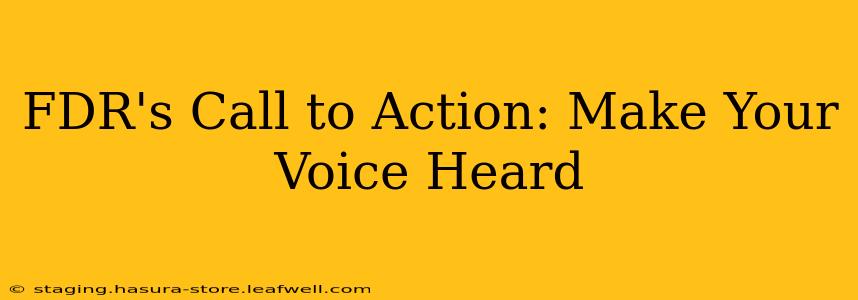Franklin Delano Roosevelt's presidency (1933-1945) was a period of unprecedented change and challenge for the United States. Faced with the Great Depression and the looming threat of World War II, FDR masterfully used his communication skills to rally the American people and inspire action. His calls to action, delivered through fireside chats, speeches, and executive orders, resonated deeply, shaping public opinion and driving significant policy changes. This article explores the various ways FDR encouraged citizen engagement and how his methods continue to influence political communication today.
What were FDR's main calls to action?
FDR's calls to action weren't singular events; they were a consistent theme throughout his presidency. He consistently urged Americans to participate in the democratic process and contribute to the nation's well-being, adapting his message to the specific crisis at hand. His primary calls to action revolved around:
-
Overcoming the Great Depression: FDR's "New Deal" programs weren't simply government initiatives; they were a call to collective action. He appealed to Americans to trust in government intervention and participate in programs designed to alleviate poverty and stimulate the economy. This included supporting the Civilian Conservation Corps (CCC), the Works Progress Administration (WPA), and the Social Security Act. His message was clear: national recovery required a collective effort, and individual participation was essential.
-
Preparing for and Winning World War II: As the threat of war loomed, FDR's calls to action shifted to national defense and global responsibility. He urged Americans to support the war effort through rationing, bond purchases, and participation in civilian defense programs. His speeches instilled a sense of national unity and purpose, emphasizing the need for sacrifice and collective action to defeat fascism.
-
Expanding Civil Rights: While progress was uneven, FDR's administration took steps to address racial inequality. His executive orders banning discrimination in defense industries were a significant call to action, though it fell short of the sweeping changes many advocates demanded. The fight for civil rights became another area where FDR implicitly urged action, particularly from those who sought a more equitable society.
How did FDR's communication style impact his calls to action?
FDR's success in mobilizing the public stemmed from his masterful communication style. His famous fireside chats, delivered directly to American homes via radio, established a personal connection with the electorate. This intimate style fostered trust and encouraged citizens to view him as a leader who understood their concerns. He spoke plainly, avoiding jargon, and framed his calls to action in terms of shared national goals, emphasizing the importance of collective responsibility.
What were the key elements of FDR's successful communication strategy?
Several key elements contributed to the effectiveness of FDR's calls to action:
- Empathy and Understanding: FDR demonstrated empathy for the struggles of ordinary Americans, connecting with their hardships on a personal level.
- Clear and Concise Messaging: He avoided complex language, ensuring his message was easily understood by a broad audience.
- Inspiring Hope and Confidence: Even in the face of immense challenges, FDR projected optimism and confidence, inspiring hope and encouraging people to believe in a brighter future.
- Strategic Use of Media: He effectively utilized radio broadcasts and other media to reach a massive audience, ensuring his message was disseminated widely and effectively.
How did FDR's calls to action shape American society?
FDR's calls to action fundamentally reshaped American society. The New Deal programs created a larger role for the federal government in addressing social and economic issues, leading to the expansion of social safety nets and a greater sense of collective responsibility. The war effort fostered national unity and galvanized American industry, transforming the country into a global superpower. Although his actions on civil rights fell short of some ideals, his calls implicitly laid the foundation for future movements seeking broader equality.
What lessons can modern leaders learn from FDR's approach?
Modern leaders can learn valuable lessons from FDR's approach. Building trust through clear, empathetic communication, utilizing diverse media platforms effectively, and framing challenges in terms of shared goals are all crucial for inspiring public action. Emphasizing the importance of collective effort and fostering a sense of national unity remains essential for navigating complex challenges and achieving common objectives. The power of connecting directly with citizens, regardless of the means, remains as potent today as it was during the Roosevelt era.

